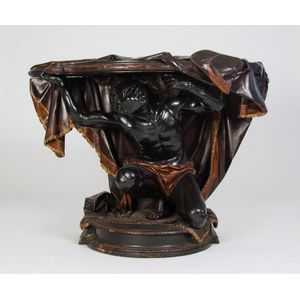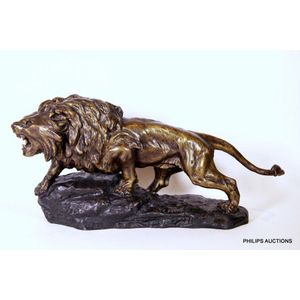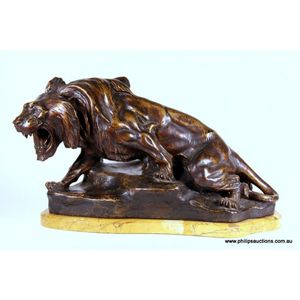Terracotta Lion En Furie by T. F. Cartier
You must be a subscriber, and be logged in to view price and dealer details.
Subscribe Now to view actual auction price for this item
When you subscribe, you have the option of setting the currency in which to display prices to $Au, $US, $NZ or Stg.
- Cartouche - An ornamental panel in the form of of a shield, oval or rectangular scroll with curling edges. It may be carved into the back of a chair or the top of a sideboard, or present on a piece of silver or jewellery, and contain the initials of the original owner, heraldic symbols, or some other inscription, such as the details of a presentation.
In ceramics the term defines the central area of a vase or similar with a decorative border in one of the shapes above, into which a decorative scene or figures have been painted. - Terracotta - Terracotta is lightly fired earthenware, red or reddish-brown in colour, used in ancient times. Fired at higher temperatures terracotta was used in the nineteenth century for decorative vases and similar objects, but rarely for utilitarian goods. Other uses for terracotta include roofing tiles, garden pots and ornaments. Glazed terracotta is known as faience.
- Verso - Verso is the "back" side of a sheet of paper, art work, coin or medal. The front side is "recto".
- Bronze - An alloy of copper and tin, traditionally in the proportions of about 9 parts of copper to 1 part of tin.
The discovery of bronze in Western Asia in the 4th century enabled people to create metal objects which were superior to those previoulsy possible because of its strength and hardness, and it has been used throughout the world for weapons, coins, tools, statuary and other decorative items.
It is very fluid in a molten state, and its hardness, strength when set, and non-corrosive properties makes it most suitable for casting sculpture.
This item has been included into following indexes:
Visually similar items

A Chinese soapstone lion, late Qing Dynasty to Republic era, early 20th century, Utilising the natural richness of the russet stone, and depicting a roaring male lion upon a rocky base, with incised character marks to base and also an incised sketch of a l

An Art Deco spelter Panther sculpture by M. Leducq (1879-1955), circa 1920s-30s, the prowling panther in earthy olive tones supported on a black marble plinth with cream onyx veneer, with impressed mark of M Leducq to the back leg. Height 19 cm length 66 c

A rare polychrome decorated and carved blackamoor console table, Italian 19th century. 93 cm high, 93 cm wide and 63 cm deep. Provenance: Private Collection, Northern Beaches, Sydney, NSW

A spelter figure of a Snarling lion by Thomas-Francois Cartier (1879-1943), a stalking tense lion in golden brown colours upon a tiered rockwork style base, incised signature of T. Cartier, height 30 cm, width 58 cm, depth 21 cm
